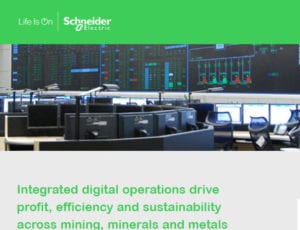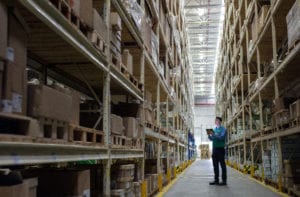An integrated operations management approach
Assessing digital transformation benefits
According to World Economic Forum, digitalization in the mining, minerals, and metals industries has the potential to deliver over $425 billion in shareholder, customer and environmental value by 2025. Much of this value will come in the form of operational effectiveness, increased productivity, faster decision-making, and enhanced safety. However, cashing in on the digitalization opportunity will require strategic planning, strong partnerships, the realignment of the employee culture, and appropriate digitalization technologies.
Companies are looking to modernize operations in order to remain competitive. These operators are faced with the issue of working within silos. Many workers are in separate departments working on spreadsheets, highly customized applications, and out-of-date solutions with no real ability to share the data they produce. Such a siloed mode of operation leads to inefficiencies that propagate mistakes and that prevent streamlining of processes.
The challenge is how to best get started down the digitalization path. Today, open architectures are accessible to enable digitalization by providing closely coupled linkages with a cybersecure envelope across the smart device, edge control, and apps and analytics layers of mining, minerals and metals enterprises. This approach increases field to enterprise transparency and enhances value chain visibility and efficiency all along the asset life-cycle.
The nature of digitalization is evolution and not revolution. Embracing a gradual, scalable approach, enables the measured introduction of modernization in the form of production, maintenance, operator enablement, and / or workforce building blocks. These days, competitive advantages in the mining, minerals, and metals industries rely heavily on an ability to gain holistic insight of operations, an Integrated Operations Management approach, from design to maintenance.
Digitalization life cycle impact
1. Efficiency starts in the design phase
Such a holistic view, enabled by an open architecture, provides new linkages and deeper integrations across core power and process systems. On the design and engineering front, for instance, hybrid DCS (HDCS) and PLC’s can integrate seamlessly with configuration, analytics and digital optimization technologies that would have been impossible or highly complex to implement in the recent past. Engineers can now configure and operate an entire automation system based on the distributed control system, with gains such as engineering time and cost reduction, minimized downtime, new testing capabilities, scalability or rich access to asset information.
Consider also the example of digital twin. According to Gartner, 50% of large industries will use digital twins by 2021. These software simulation tools provide mining, minerals and metals operators with virtual models for both the engineering / design phases of a project and also for refinement of operations. A digital twin’s power is that it allows engineers to observe the physical asset’s behavior without spending money to build it, and then improves the overall design by iterating through different operating conditions.
2. Drive production management efficiencies
Improving productivity across the value chain is critical for maintaining competitiveness. This can be achieved by addressing in an integrated way, different aspects that impact production activity – from planning, when an Unified Supply Chain Management help achieving agile and collaborative decisions between multiple sites in the value chain network for better scheduling; to execution by enabling process stabilization and optimization and providing operator support in helping to drive machine productivity closer to process limits.
Continuous operations are the key to solving many production issues and to improve. MMG, a mining company that operates globally, has emerged as a reference in delay accounting, the measure of lost time when operating assets or processing. By using a standard approach MMG has increased asset utilization by at least 10% across multiple global sites.
EcoStruxure Advisors, are a specialized suite of smart manufacturing apps and digital services that also provide collect, measure and analyze cloud-based and plant-wide data and recommend cost effective actions to take for continuous improvement. Some of these advisors use machine learning techniques to better tune mining, minerals and metals processing plants. Specific plant parameters are set such as speed, and how much chemical is added, for example, to achieve an optimal operating point.
3. Tighter management of energy to reduce costs and guarantee uptime, while fostering sustainable operation
Despite efforts, overall energy usage is rising. Demand for electrical energy in the copper industry, for instance, is forecast to grow at 4% (CAGR) through 2026. Better control of these costs using digital solutions in now possible.
Energy is one of the top five expenses for Saint-Gobain. They have saved millions of dollars in energy costs working out their energy planning and improving stages through the use of cloud-based energy management tools like EcoStruxure Resource Advisor. By being focused on buying energy smarter and using it efficiently, and centralizing energy procurement, resources are also freed up to deliver leading-edge, sustainable solutions. Through use of digitized technologies, plant operators can now track and control energy use based on the time of day, and trim consumption when grid-wide use and prices peak.
During execution, in many remote sites, microgrids are beginning to play a more important role in maintaining business continuity. The newest generation of microgrids has become much smarter due to the integration of digitalized, predictive technologies. Cloud-based solutions like EcoStruxure Microgrid Advisor, for example, serve multiple roles such as providing a Human Machine Interface (HMI) for site managers, processing demand / response requests, optimizing output decisions based on energy tariff rates and weather forecast predictions, and factoring in user / customer constraints. As a result, energy bills can be minimized, and carbon footprint decreased.
4. Digitalized asset management to efficiently extend asset life
Within the mining, minerals and metals industry, 40% of OPEX is generated through maintenance activities. In fact, most asset maintenance costs will far exceed capital costs over the life of the asset. In some mining operations, more than 60 % the total site workforce is exclusively dedicated to maintenance.
During planning, comprehensive Enterprise Asset Performance Management (APM) improves asset performance by integrating risk and asset criticality into an overall asset performance management strategy. The software generates optimized maintenance and spare parts strategies by first looking at the company’s business strategy and objectives, and then prioritizing actions down to an individual asset level to maximize return on asset investment, establishing recommendations to choose from reactive, preventive, or predictive maintenance. Good example on preventive maintenance is EcoStruxure Asset Advisor, cloud-based maintenance solution that brings a proactive approach to managing power assets, addressing issues before they become critical incidents.
During execution, augmented reality is beginning to change the way maintenance in remote sites is being performed. It provides maintenance technicians with tablet-driven graphical views of the inside of machines, without ever having to open up a panel, which greatly enhances worker safety. Instant access to real-time information speed ups identification of the issue and visually displays the proper procedures for applying a fix. This helps to reduce the human error commonly associated with traditional maintenance procedures.
Digitalization and integration can only be embraced by strong partnerships
Aligning industrial processes with big data capture, storage, and analysis can save enterprises millions of dollars in investment cost and shorten their time to market by months or even years.
The strategic partnership of two key industrial energy management, automation and software businesses, Schneider Electric and AVEVA, is designed to facilitate digital transformation across capital-intensive industrial asset and operational life cycles. Schneider Electric strengths in open scalable platform architecture, EcoStruxure for Mining, Minerals, and Metals, and in energy management, coupled with AVEVA’s ability to create collaborative software environments, act as a clear market value.
 Download this e-Guide today to learn more about how integration and digitalization create collaborative business and operations environments for enhanced business performance in resources industries.
Download this e-Guide today to learn more about how integration and digitalization create collaborative business and operations environments for enhanced business performance in resources industries.





Conversation
I am looking for a job in Digital Marketing.
Thank you for your interest in Schneider Electric. Please take a look at our careers page for any current openings with us. https://www.se.com/us/en/about-us/careers/overview.jsp